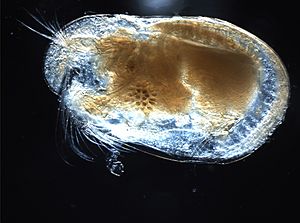Ostracod facts for kids
Quick facts for kids OstracodaTemporal range: Cambrian to Recent
|
|
|---|---|
 |
|
| Scientific classification | |
| Kingdom: | |
| Phylum: | |
| Subphylum: | |
| Class: |
Ostracoda
Latreille, 1802
|
Ostracods are a group of tiny crustaceans. They are often called seed shrimps because they look a bit like tiny seeds. There are about 65,000 known types of ostracods, but only 13,000 of these are still alive today.
Contents
Tiny Crustaceans with Shells
Ostracods are usually very small, often around 1 millimeter (0.04 inches) long. Some can be as tiny as 0.2 millimeters (0.008 inches). The largest known ostracod, Gigantocypris, can grow up to 30 millimeters (1.2 inches) long!
Their bodies are flat from side to side. They are protected by a hard, two-part shell, much like a bivalve such as a clam. This shell is made of a tough material called chitin or calcium carbonate. The two halves of the shell are joined at the top of their body.
Where Do Ostracods Live?
Ostracods live in many different places. Many marine (ocean) ostracods are part of the zooplankton. This means they float and drift in the water. Other ocean ostracods live in the benthos. This means they live on or in the top layer of the sea floor.
You can also find many ostracods in fresh water, like lakes and rivers. Some special types, like Mesocypris, even live on land! These land ostracods are found in humid forest soils in places like South Africa, Australia, New Zealand, and Tasmania.
What Do Ostracods Eat?
Ostracods have a wide range of diets. This group includes different kinds of eaters:
- Carnivores eat other small animals.
- Herbivores eat plants.
- Scavengers eat dead plants or animals.
- Filter feeders strain tiny bits of food from the water.
Images for kids
-
Articulated ostracod valves in cross-section from the Permian of central Texas; typical thin section view of an ostracod fossil
See also
 In Spanish: Ostrácodos para niños
In Spanish: Ostrácodos para niños





